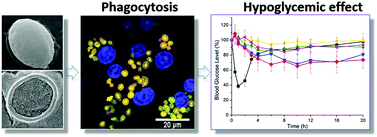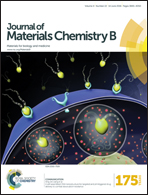Glucan microparticles thickened with thermosensitive gels as potential carriers for oral delivery of insulin†
Abstract
Although glucan microparticles (GMs) can be efficiently taken up and transported by M cells, their subsequent accumulation in lymphatic tissues of sub-follicle-associated epithelia (FAE) in Peyer's patches might present a barrier to the oral delivery of insulin by GMs into the systemic circulation. The goal of this study is to weigh the potential of GMs as carriers for oral delivery of systemic therapeutics using insulin (INS) as a model drug. INS is encapsulated into the inner cavities of GMs by repeated soaking in INS solution at acidic pH values and switching to an isoelectric pH of 5.6 to precipitate INS. To immobilize INS, a thermosensitive poloxamer 407 (P407) gel is introduced into the interior of GMs. Interiorly thickened GMs show significantly decreased in vitro release and well protected INS stability against enzyme-enriched media, highlighting the importance of thickening with P407 gels. A mild and prolonged hypoglycaemic effect is achieved in both normal and diabetic rats for a duration of at least 20 h with pharmacological bioavailability as high as about 9–10%. Lymphatic transportation of GMs is investigated by labelling with a near-infrared water-quenching fluorescent probe in a conscious mesentery lymphatic duct cannulation rat model following oral administration. GMs appear in lymph within the first 2 h, peak at around 6 h and slow down after 10 h with a cumulative amount of over 8% in 24 h. The high correlation between lymphatic transportation and pharmacological bioavailability implies that GMs are principally absorbed via the lymphatic route. An in vitro study on phagocytosis by macrophages confirms the easy and fast uptake of GMs by J774A.1 cell lines with as many as over 10 particles within the cytoplasm of a single cell. Intracellular pharmacokinetics indicates robustness and persistent residence of GMs within the cells. Little effect on cell viability and tight junctions was observed in Caco-2 cell models. It is concluded that GMs are mainly absorbed via the lymphatic route and show potential as carriers for oral delivery of labile therapeutics, though with limited bioavailability due to the sub-FAE residence barriers.


 Please wait while we load your content...
Please wait while we load your content...